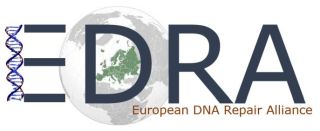|
|
|
Previous webinars > 4th webinar 06/07/20224th EDRA Webinar June 7, 2022, from 4.30 to 6 pm CET Dr Marie Dutreix - Directeur de Recherche au CNRS, Equipe "Réparation, radiation et thérapies innovantes anticancer, Institut Curie, France Disabling of DNA repair response by short DNAs (AsiDNA) We used stable short DNA molecules (AsiDNA) to analyze DNA repair early events from the detection of DNA breaks to the formation of DNA repair foci after irradiation. AsiDNA is a DNA repair inhibitor already tested in clinic which was designed to mimic DNA double-strand breaks. We show that after cell uptake AsiDNA is bound by ATM and PARP in the cytoplasm and triggers their activation in absence of irradiation. ATM activation by AsiDNA leads to its transient autophosphorylation and sequestration in cytoplasm that impairs the formation of ATM foci on irradiation induced damage. In contrast the activation of PARP does not seem to alter its ability to form DNA repair foci but prevents 53BP1 and XRCC4 recruitment at damage site. In nucleus, AsiDNA is essentially bound by DNA-PK and triggers its activation leading to phosphorylation of H2AX all other the chromatin which correlates with a massive inhibition of the recruitment of the repair enzymes involved in DNA double-strand break repair by Homologous Recombination and Non Homologous-End Joining repair at damage sites induced by irradiation. These results highlight the interest of a new generation of DNA repair inhibitors targeting the DNA damage signalling.
Short 15-min talks: 1. Pierre Caron- Laboratory of Epigenome Integrity, Paris. Dynamics of heterochromatin domains in response to DNA damage. The integrity and stability of our genome is ensured by multiple DNA repair pathways. Over the past decade, several studies have unveiled the key contribution of chromatin dynamics and histone post-translational modifications in the response to DNA damage. Conversely, DNA damage leads to massive chromatin rearrangements that can impair DNA operations such as transcription or replication. In this talk, I will present recent results and tools developed in my former post-doctoral lab (Sophie Polo) to study the mechanisms underlying the maintenance of heterochromatin domains in response to DNA photoreaction and double-strand breaks. 2.Sayma Zahid- Institute for Integrative Biology of the Cell, Saclay. Structural study of the complex formed by the Werner protein (WRN) and the Ku70/Ku80 heterodimer Chemotherapy or radiobiology treatments aim at generating DNA double-strand breaks (DSBs). Tumor cells are more sensitive to DSBs than healthy cells due their phenotype and genotype[1]. One important axis in radiobiology is to combine radiation therapy with inhibitors of the DNA repair pathways to increase radio-sensitivity and overcome radiation resistance of some cancer cells[2]. Our objectives is to unveil the molecular mechanism of the NHEJ (Non Homologous End Joining) pathway and to characterize new specific inhibitors of this pathway. Ku70/Ku80 heterodimer (Ku) is a central player of the NHEJ for DSB recognition and in downstream DNA events (processing and ligation steps). Our team showed that Ku is able to recruit several factors of the NHEJ pathway through direct interactions and thus acts as a hub that coordinates the whole NHEJ[3][4][5]. Many interactions involve motifs called KBM (Ku Binding Motif). When DSB ends need to be processed, enzymes are necessary to correct the extremities prior to the final ligation step. One of these enzymes is Werner (WRN) thathas two KBM motifs. This protein is part of the helicase RecQ family. It is the only member of this family to have in addition to its helicase domain, an exonuclease domain. It is particularly studied in the case of Werner Syndrome, a rare autosomal-recessive inherited disease, characterised by an early aging[6]. It was also identified as a promising drug target for frequent cancers presenting local DNA instability[7], but little is known about its role in the NHEJ pathway. During my PhD, I successfully produced several WRN constructs and full-length protein to study them by combining multiple structural approaches. I showed that WRN can adopt several oligomeric state using SAXS and SEC-MALS, and that WRN interacts directly with Ku through two peptidic motifs, located in N-terminal and C-terminal extremity. I determined the CryoEM structure of a Ku-DNA complex bound to the exonuclease domain of WRN at 3.3Å of resolution. We showed that Ku recruits WRN through its KBM motif and position the exonuclease domain of WRN near the DNA. Our collaborators analysed by life cell imaging and enzymatic assays the Ku-WRN interaction and observed a stimulatory effect of Ku on WRN function in good agreement with our data.
|



